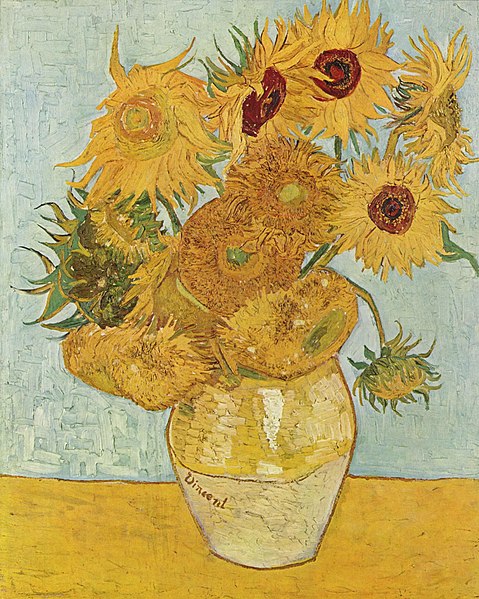The word 'yellow' is defined as being "the colour of egg yolks or ripe lemons...cowardly...become slightly yellow with age." (1) This shows that the word has a wide range of meanings depending on the context used, though it is mostly used to describe the visual properties of an object.
Yellow is seen as a colour that represents warmth, as it is linked with the sun's light. As such it adapts the underlying emotional effects of being in the sunlight; when a person sees yellow, they may emotionally connect it to happiness. The sun affects your mood dramatically by giving off Vitamin D, and for many people that have enough exposure to it, there is an increase in levels of happiness. (2) This representation is applicable across many forms of media. Within the art world, yellow is one of the three primary colours that can be mixed with each other to create all remaining colours - making it one of the most important tools in creative expression. As with all elements of art, yellow has a much deeper assortment of meanings than simply warmth and positivity. While lighter tints of yellow can represent things that are bright, new and joyful, darker shades are more commonly associated with envy, sickness and decay. (3)
 One example of such artwork that incorporates lighter yellow tints is Van Gogh's painting of sunflowers (right). (4) As can be seen in this famous painting, bright tints are used for the fresh, blossoming sunflowers. There is an overall atmosphere of joy and peace in this artwork, which ironically does not mirror the condition of Van Gogh at the time of its creation. He grew increasingly unstable over his adult years, in what some would call his 'descent into madness,' before he committed suicide. During this breakthrough period, Van Gogh experienced a bout of intense activity - painting seventy canvas pieces in just as many days. (5) This simply shows that you cannot judge the creator's personality on the nature of what they have created.
One example of such artwork that incorporates lighter yellow tints is Van Gogh's painting of sunflowers (right). (4) As can be seen in this famous painting, bright tints are used for the fresh, blossoming sunflowers. There is an overall atmosphere of joy and peace in this artwork, which ironically does not mirror the condition of Van Gogh at the time of its creation. He grew increasingly unstable over his adult years, in what some would call his 'descent into madness,' before he committed suicide. During this breakthrough period, Van Gogh experienced a bout of intense activity - painting seventy canvas pieces in just as many days. (5) This simply shows that you cannot judge the creator's personality on the nature of what they have created. --------------------------------------------------
In researching the word 'yellow,' I first used a dictionary to find its definition, in order to get a solid description of what the word represents. Then I went onto the Internet to explore the representations of yellow as a colour, including a scientific explanation of the link between the colour and the warmth of sunlight. Next, I found it appropriate to research yellow's importance in the art world, including how variants of the colour have a larger array of artistic meanings than once thought. Afterwards, I continued to use online resources to find an example of artwork that would justify one of the aforementioned representations of selected variations of the colour yellow. I felt that the natural conclusion to this research would be to further divulge into the life of the artist behind this example, using information found online.
--------------------------------------------------
(1) Hawker, S. (2006) Colour Oxford English Dictionary. Oxford, England: Oxford University Press.
(2) The Huffington Post, (2016). Simple Lifestyle Change Linked To Improved Moods. [online] Available at: http://www.huffingtonpost.com/2013/10/06/sunshine-happiness-behavior-mood_n_4014477.html [Accessed 15 Feb. 2016].
(3) Finearttips.com, (2010). The Color ‘Yellow’: The Hidden Meaning for Your Art & Design - The Art and Fine Art Tips with Lori McNee. [online] Available at: http://www.finearttips.com/2010/07/the-color-yellow-the-hidden-meaning-for-your-art-design/ [Accessed 15 Feb. 2016].
(4) Van Gogh, V. (1888). Still Life: Vase with 12 sunflowers. [oil on canvas] Munich: Neue Pinakothek.
(5) Thorpe, V. (2000). Van Gogh letters shed new light on his 'madness'. [online] the Guardian. Available at: http://www.theguardian.com/uk/2000/dec/10/vanessathorpe.theobserver [Accessed 15 Feb. 2016].
No comments:
Post a Comment